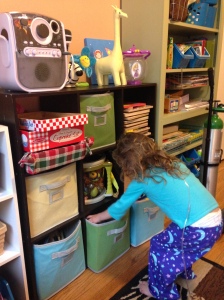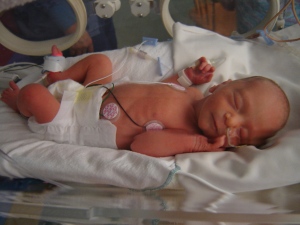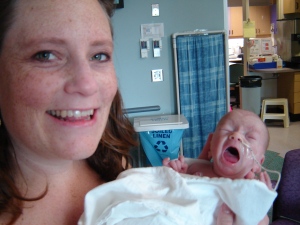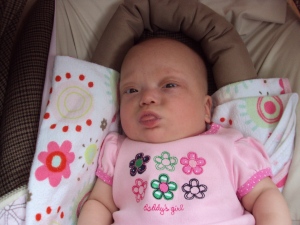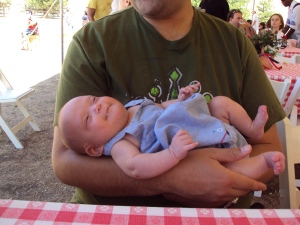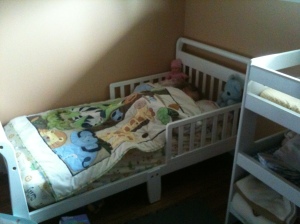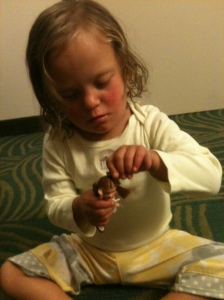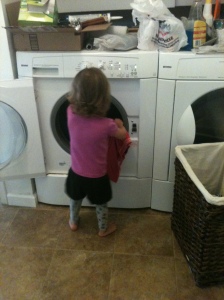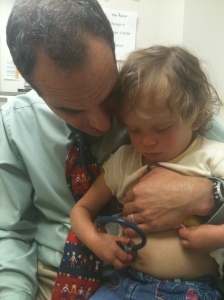Today, I blogged about Motherhood on CherishWords – my other blog. Normally, I write about the Bean here, but for some reason – maybe because it is Mother’s Day, this one ended up there. So, if you’d like to read it, you can get to it here. Just so this page is less boring, here are some recent pictures of the Bean.
Author Archives: Bethany Seto
My First Public(ish) Speaking Engagement about Special Needs
A few weeks ago, along with a good friend of mine, I spoke at my MOPS (Mothers of Preschoolers) meeting about raising Special Needs kids. We both told brief versions of our journeys, and then talked a little about how our Typical Mom friends can relate to us, include us, and otherwise support us. It was an emotional and positive experience. We were surrounded by much love and encouragement, and there were tears happening all over the room. Below, I’ve included my talk. Of course, it came out a little different than this. I had my friend record video of the first part of my talk – the part about Jenna’s story. Then she joined me for the part about how our friends can help, so that part is only in written form.
To watch the video, go here. To read the second part of the presentation, go here.
Jenna was two days old when we found out that she has Partial Trisomy 22 – a very rare duplication of genetic material in her 22nd chromosome. We knew something was wrong when she wasn’t growing properly in the womb, and knew she would be admitted to the NICU immediately after she was born. We were expecting her to be tiny, and she was: 3lbs, 13oz and 17 inches long. We were expecting her size to have something to do with the placenta, or her ability to absorb nutrients…we weren’t expecting a genetic condition that, as we soon discovered, meant that our little girl would have severe global developmental delays. We also later discovered that she has a hole in her heart – an Atrial Septal Defect.
The three weeks we spent in the NICU were enough to teach her to drink breast milk from a bottle and start gaining weight. I would visit the hospital twice a day to bring my expressed milk, practice nursing, and bond with this tiny human that was my daughter. I had to re-learn how to change diapers and wash a baby, despite years of babysitting, because I had just never handled a baby this small. Family and friends visited, we asked a lot of questions of the nurses, we had regular meetings with her doctor to discuss her various tests, and finally, we took our tiny infant home.
Two days later, a moving truck came to pack up all our belongings, and my husband, Devin moved to California because early in my pregnancy, he had accepted a job down here. Jenna and I moved into my parents house for three weeks to complete the sale of our house, get Jenna’s passport and complete the post-discharge medical appointments. It was extremely stressful to be apart from Devin, and to have so many important things to take care of while also getting used to being a Mom, and trying to nourish our tiny baby.
To say that starting life as a new mother with a Special Needs baby was a little scary is putting it mildly. To start that life hundreds of miles away from any friends, family, familiar medical system and citizenship was overwhelming. But we knew we had made the right decision to move to California, so we asked a lot of questions, and then trusted that everything would be okay.
Over the next three years, my life was filled with appointments: with pediatricians, neurologists, cardiologists, opthamologists, hearing specialists, speech therapists, physical therapists, oral motor therapists, and Early Interventionists (EI).
Mealtimes were painful. At first, it would take Jenna an hour to drink 4 oz of milk from a bottle – she never did learn to nurse. When she started on solid foods, her therapists taught me special ways to feed her with a spoon to help with her various oral motor issues. Most of her food ended up on her clothes thanks to a tongue thrusting motion that is common in Special Needs kids. It took a long time for her to start feeding herself even with her hands, since her pincer grasp was so late to develop. For the first two years of her life, I dreaded feeding my child because it was a long and frustrating task. Every morsel of food was a therapy tool. However every success was met with a major celebration.
Physical and EI Therapy sessions were just as frustrating. At first, Jenna refused to pay any attention to the toys we were using to teach her to reach for things, or roll over, or grasp, or whatever the task was at the time. She did a lot of crying during therapy sessions. It was heartbreaking. We persevered and got creative with new ways of getting her attention and finally started to make some very slow progress.
Jenna smiled for the first time at 12 weeks – from 8 weeks (typical smiling age) until she finally smiled I was terrified that she never would. She sat on her own at 12 months, cut her first tooth at 14 months, scooted around on her bum for a couple of years, pulled up to standing at 2.5 years old, and finally started walking with a walker at 3 years old. Needless to say, I threw out all the books that tell you “What to Expect” from your child.
We joined a Mother’s club shortly after moving here, and made some very sweet friends. But I was the only one in my group with a special needs child, and it was lonely having the only child who didn’t react to tickling. Then it was lonely sitting with Jenna in the sandbox while all the other parents were helping their kids on the play structure. And then it was lonely being on the play structure with Jenna when all the other moms were sitting around chatting, because their kids could navigate the play structure alone.
We didn’t go to baby gymnastics, music classes, playtime at the library, or any of those other programs that my friends were doing with their kids, because we had therapy 5 days a week. For an extravert like me, all that loneliness was devastating and I eventually figured out that I had fallen into depression. Even so, I made friends and started creating a support network in the Bay Area. Jenna’s therapists became my therapists, and I know I talked their ears off. I still do.
One of our most trying times in her early years was just before she turned one. She was hospitalized twice in two months for RSV and Pneunomia, the first time for 5 days, and the second for 2 weeks. It was a scary time because the hole in her heart added extra risk, and it was tough to handle without family around. But our friends stepped up to the plate like champs and fed us and walked our dog and sent us encouraging notes. They were wonderful.
When Jenna turned 3, she graduated out of the therapy program supported by the Golden Gate Regional Center, and entered preschool in the county program at Marindale in Terra Linda. Some Moms cry when their kids start school. When I dropped Jenna off at school the first day, she was fine, and I skipped down the hall singing “Freedom is Coming”.
After three years of non-stop therapy, full-time care, and dragging (actually carrying) her with me everywhere I went, I finally had some “me” time. She started getting all her therapies at school and I was no longer involved in most of her sessions. Having 4-hour chunks of time in which to get things done around the house, or take a nap, or run an errand without a child along were pure paradise. I know you all know what I’m talking about here.
Sleep was always an issue. I wasn’t able to sleep train Jenna at the ideal time because she was so small that feedings in the night had to continue until she was 6 months old. I’m not sure it would have helped, though. I’m such a softie and can’t handle just letting her cry. I can count on two hands the number of times in her life that she has slept through the night: She’s 5. So sleep deprivation has been a major challenge for me since the beginning and still continues. We gave up on sleep training after 3 years of trying out of desperation for some sleep for ourselves, and I started sleeping with Jenna in the spare room when she got up in the night.
Our biggest challenges after school started were the arrival of some pretty epic temper tantrums. She is a very strong-willed child, which will serve her well, but it makes for some trying times coupled with her challenges with communication. She developed some annoying (sometimes infuriating) habits like kicking me in her sleep, pinching me to comfort herself or get my attention, and digging in her diaper and smearing the contents all over whatever room she is in. Mostly normal behaviours for kids at some point in their development, but when it lasts for years instead of months, it’s hard to accept. She is also very loud – she has two volumes: silent and deafening. Learning the concept of quiet is slow going.
Now, Jenna is 5. She walks and runs and is starting to jump even though her first Physical Therapist later admitted that she wasn’t sure any of those things would ever happen. It’s still difficult to understand what she says most of the time, but her speech is getting clearer and she’s trying to copy everything we say. It is so much fun to see her growing and learning, and becoming a little girl. She was a baby for so long, we both have some habits to break. She’s not potty trained, and I still end up sleeping with her for part of most nights. She often cries when she wants something before remembering that she can use her words to ask for it. For my part, it takes concentration to let her do things for herself instead of stepping in to help every time. But her independence is growing. She’s a happy, goofy, active child, and everyone who meets her falls in love immediately. For that, we feel so blessed.
I waited much too long to connect with other Moms of Special Needs kids. With such a rare condition, I didn’t think Moms dealing with other diagnoses would have much to offer me. I was so wrong. Now that I have friends in the Special Needs community, I no longer feel so lonely. And it’s not that my “Typical Mom” friends aren’t there for me. They are amazing! YOU are amazing. But you don’t know what I’m going through because you haven’t experienced it. It’s not your fault.
To read the tips we gave to our friends in the meeting about how to relate to us and be sensitive to people dealing with special needs, go here.
How to Relate to a Special Needs Mom (or Dad)
As part of my presentation to the Marin Mops group in April, my friend and I came up with some things we want our Typical Mom friends to know. There are a lot of these kinds of lists on the Internet. This is ours.
1. We are just Moms – we’re not super-women.
If you had been given a Special Needs child, you would have risen to the task too. That said, we sometimes need you to acknowledge that our lives are HARD. We deal with behaviours and challenges that you can hardly imagine, and chances are that we only show you that stuff if you’re our closest friend. Because even though we are not Super-Moms, we ARE strong.
2. Just because OUR lives are hard, doesn’t mean that we don’t realize that yours are hard too.
We want to be there for our friends as well. I have friends who are single parents, or are dealing with chronic illnesses of their own, or have ugly family drama, or have severe financial difficulties. Most of the time, I feel blessed, not cursed, by my life.
3. Every parent worries about their child.
For you, those worries may include: will he/she ever find the right mate, be a good parent, get a good job, skin their knee or break their arm on the playground? Those things also worry us.But we also worry about whether our children will ever be independent enough to move out of the house, or will we be their primary caregiver for the rest of our lives? How will they be cared for after we’re gone? Will they have friends in school or will they be too different and sit on the sidelines? Will they be able to stand up for themselves if they are bullied. Will anyone else stand up for them if they are bullied?
With a daughter, I worry about whether she will understand what sex is and be able to fend off potential abusers. Will she ever want kids, and how will we deal with that issue? How will she handle normal female things like puberty, crushes, self-esteem issues. Will she have a best girlfriend to accompany her on this journey?
For parents of kids with medical problems, worries will include things like: will they make it to adulthood? Will they make it to their 10th birthday? Even though it’s a routine procedure, I worry about whether Jenna will make it through her open-heart surgery this summer. These are some pretty major things to worry about. These are the things that, if we are praying people, we are offering up to God on a daily basis.
4. A lot of our worries would be less scary if we lived in a world where everyone was accepted and included.
You can help with that by coaching your kids and teaching them to be kind to everyone.I get a lot of questions about Jenna from kids at the playground, and I LOVE to talk to those kids and help them understand that not everyone learns and grows like they do. I would rather they asked questions than just ignored us or stared at Jenna without interacting. I introduce Jenna and myself to kids and let them know that she would love to play with them, because she doesn’t know how to do that for herself yet. But not all parents of special needs kids are that outgoing or comfortable, and sometimes they need others to take the initiative.
As parents, you can help with this process by being open and friendly yourself. Talk to Special Needs kids and their parents at the park or in your gymnastics class like you would with any other family. If you act uncomfortable and awkward, they will pick up on that and know something is wrong. Your kids will see your example and imitate it, so make it a loving example.You can also talk to your kids about differences at home, and answer their questions with age-appropriate responses. I’ll often tell kids that Jenna just doesn’t grow as fast as other kids, and that’s why she’s so much smaller. When they ask why she talks funny, I tell them that her mouth is still learning how to make some sounds, and it’s going to take a while for her to be able to talk like they do, but that she loves to talk and sing anyway.
5. When getting to know a parent with a Special Needs child, here are some important guidelines to follow:
Never imply that the condition was caused by the parent. The topic of vaccines, for example, is a touchy one even though the medical community has discounted the claims that vaccines and autism are related. Yes, some conditions are caused by excessive substance abuse during pregnancy, or horrible accidents, or what have you, but most of the time, that’s not the case, and unless the information is offered, it’s also none of your business.
DO express genuine interest in the story of our lives. We want to be known. Sometimes parts of our stories might be too personal or painful to talk about until we know you better, but your friendship means the world to us.
Don’t give unsolicited parenting or therapy advice. Unless you are an expert in the field and have recently discovered some new data, the chances that you have any suggestions that haven’t already been considered are very slim.
DO ask about what kinds of therapies our children are in, and seek to understand what that involves. Ask us what our challenges are with our special kids and let us vent. That said, not everyone wants to talk about their situation, so respect that as well.
Don’t pity us or patronize us. We don’t want to be anyone’s charity case.
DO be empathetic, friendly, open-minded, supportive, and loving. We need all the love and support we can get. Invite us to your birthday parties and BBQs, and try to be sensitive to our needs and understanding about our kids’ behaviour. We’re already second-guessing most of our own actions, and worried about what others will think. We want people to understand our kids so that when there is a behavioural issue or our frustration leaks out in public, we don’t feel judged.
Don’t try to make us feel better with platitudes. God doesn’t “give special kids to special Moms”. Special Needs kids are born to all sorts of parents and some of them seriously can’t handle it. If we’re handling it, it means we’re good parents, not “chosen”. If the diagnosis is fresh news for us, we’re probably still grieving the potential loss of all our hopes and dreams and just need to know that we’re not alone and that we WILL be able to handle it.
DO tell us that we’re doing a great job, that you can see how hard it is and that we obviously love our children very much. If our child’s diagnosis is new for us, be super gentle. Tell us that you can’t imagine what we must be going through but want to be there for us.
The biggest thing we want to leave you with today is that a lot of people are dealing with Special Needs. Not all of those needs look the same, and it’s up to all of us to treat each other with respect, love and kindness regardless of who we are and where we are at in our lives. Teach your children to be kind to everyone. Special Needs kids have a lot to offer in friendships – teach your kids to look beyond differences to find things they have in common. And finally, some people living with Special Needs are really broken about it. Please don’t shut them out or alienate them or be afraid of them. Love them.
Learning How to Play
I recently came across this article, which explains how therapists teach young children how to play and what the benefits of that training can be. Before the Bean came along, it never dawned on me that kids would need to be taught how to play. It just seemed to come naturally for any child I had ever known. But for the Bean, playing with toys was not a skill that came naturally. She loved to look at faces and interact socially, but had no idea what to do with the brightly coloured plastic and wooden objects we placed in front of her. She just ignored them completely.
In the article, Penina Ryback defines play as, “the way children practice and internalize both the rules and roles they see around them. Play helps children make sense of how their world works.” If a child is developmentally delayed or has a condition such as autism that makes it difficult for them to notice the rules and roles they are supposed to be practicing, they need some prodding to play like other kids play.
I notice this when we play with typical kids. When presented with a new toy or concept, they explore it using what they know, and then quickly branch out into other ideas as they observe others also interacting with the same thing. But for the Bean, it’s not as smooth or effortless a process.

The Bean is more interested in sucking on her fingers than all the new toys at her birthday party, but her friends are happy to take over.
When other kids the Bean’s age were engaging in parallel play (age one or so), she was still just learning how to sit, so she couldn’t interact with the toys like other kids did. It didn’t even seem like she was watching them play – she was engaged with me and any other adults who would interact with her and make eye contact. During this time, we were getting services from Easter Seals. The wonderful woman who came to our home for an hour each week was teaching the Bean how to interact with toys, and measuring her progress based on whether she could actually grasp a toy and pick it up, or switch a toy from hand to hand.
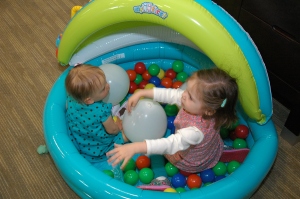
For her 2nd birthday, I made sure the activities were at her level, and luckily her typical friends thought it was fun too.
A year later, she was finally engaging with the toys that her friends were playing with a year previous, but they had moved on to more sophisticated activities. So once again, she was sitting with the adults playing with the toys while the other kids were starting to actually play with each other. Our Easter Seals therapy was focused on teaching the Bean how to stack blocks, turn the pages of board books, squeeze play doh, and matching wooden puzzle pieces to the right space on the board. She had some success, and was evaluated at about 6 months behind her peers.
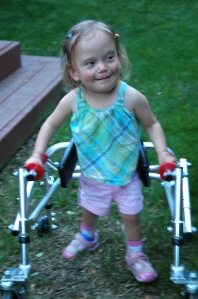
At 3 years old, she was able to get around on her own with a walker. She was thrilled to be able to move around on her feet, but she still couldn’t keep up with her friends.
When she turned three we were still working on stacking, nesting, colouring and wood puzzles, and had also added some imaginitive play, recognizing and matching colours, shapes, and knowing the difference between big and little. The Bean was finally stacking one block on top of another, recognizing colours with some consistency, and could scribble a little with a crayon, but her speech capabilities were way behind, and her ability to focus on a task for very long was minimal. Many 3 year olds are happily reciting the alphabet, counting to 10, drawing/colouring with some precision,can write their name, and are totally ready for preschool. The Bean was being prepared for preschool as well, but it was clear that she was far from ready for integration into a regular preschool, so we enrolled her at Marindale, our County’s special needs preschool. It was the best thing that had ever happened to our Bean.
Without the play therapy we received from Easter Seals, I wouldn’t have had a clue what to expect from the Bean or how to encourage the development of these skills that, in my experience, usually came naturally. During her two years at preschool so far, she has made huge strides: now stacking large lego blocks into towers, drawing with more variety, playing with her imagination, constructing parts of more complicated puzzles, and imitating others with abandon. She has gotten to the point where she wants to be able to do what other kids are doing, which shows that she’s paying attention and learning a lot from those kids. Her speech is still very far behind other kids her age, but that is progressing as well.
We are nearing the time when we have to decide what Kindergarten will look like for our Bean. We are trying to be realistic and choose the options that will ensure her continued development success without overwhelming her. Our team of teachers, therapists and administrators are so totally on the Bean’s side, that I have no doubt we’ll make the right decision together.
Things the Bean Does That Bug the Heck Out of Me!
 Every parent has certain buttons that their kids push quite easily. No matter how much we adore our kids, we don’t always love all the little annoying things they do. So, in the spirit of documentation, I give you “Things the Bean Does That Bug the Heck Out of Me!”
Every parent has certain buttons that their kids push quite easily. No matter how much we adore our kids, we don’t always love all the little annoying things they do. So, in the spirit of documentation, I give you “Things the Bean Does That Bug the Heck Out of Me!”
Pinching – The Bean doesn’t pinch in a mean way. She’s not upset or mad; it’s something she does when she’s cuddly or when she’s trying to get my attention…and I can’t stand it! She grabs tiny sections of skin in the most sensitive places and pinches, sometimes gently and persistently, and sometimes really hard. I’ve tried to just tolerate it and see if it stops on it’s own, but I just can’t. I tap her hand and say “no pinching”, I squeeze her hand, I pinch her back – all to no avail.
Throat punch – this is another one that she’s not doing with the purpose of hurting anyone, but it really sucks. It almost seems like an uncontrolled movement, except that her aim is exceptional. Sometimes she does it with the tips of her fingers; this is a self defense technique we learned in Taekwondo, and it’s very effective. Other times it’s a back fist to the throat when we’re lying down, or with the heel of her hand as she leans the full weight of her body on her hand trying to get up.
The Elbow Lean – This is almost as painful as the throat punch. The Bean tends to tends to lean on my chest with her elbows, once again putting her full weight into the experience. I’m surprised my chest isn’t black and blue.
Shrieking in the Car – I think every child goes through a stage where they’re learning how to regulate their volume, and for a time, loud seems to be the only option. Whether she’s happy or upset, the Bean can get shockingly loud in the car, and I’m trapped in my seat belt on the freeway yelling at her to stop yelling…oh the irony.
 Temper Temper – Because of her speech delays, at 4-years-old the Bean often doesn’t have the words or the patience to tell me what she needs or wants. She does try sometimes, which can be frustrating for both of us because she’s saying a word out of context without much for consonants. When many of her words sound the same, it’s a guessing game, and as she gets older her wants and needs are becoming more complex. This is all par for the course.
Temper Temper – Because of her speech delays, at 4-years-old the Bean often doesn’t have the words or the patience to tell me what she needs or wants. She does try sometimes, which can be frustrating for both of us because she’s saying a word out of context without much for consonants. When many of her words sound the same, it’s a guessing game, and as she gets older her wants and needs are becoming more complex. This is all par for the course.
The part that bugs me is when she doesn’t even try to communicate, just breaks down in tears or a tantrum for no obvious reason. I haven’t even had the chance to say no before she’s having a tantrum about it. Figuring out what she wants AND trying to teach her nicer ways to ask for what she wants become mutually exclusive tasks because the more upset she is, the less she can listen or talk to me. I’m learning to wait it out: to tell her that I can’t understand her when she’s crying/whining and when she’s ready to tell me what she wants, I will do my best to understand her. It sometimes takes a while.
 Everything in the mouth – Most kids grow out of this phase when they’re three – at least I assume so because all those toys and games with small pieces are labelled 3+. The Bean, however, still explores a lot of things with her mouth: stones from the driveway, small pieces from toys, large pieces from toys, blocks, anything from her toy kitchen, the water and bubbles from her bath, finger paint, playdoh, as much dirt and sand as she can get away with before I freak out, and even her own poop from time to time.
Everything in the mouth – Most kids grow out of this phase when they’re three – at least I assume so because all those toys and games with small pieces are labelled 3+. The Bean, however, still explores a lot of things with her mouth: stones from the driveway, small pieces from toys, large pieces from toys, blocks, anything from her toy kitchen, the water and bubbles from her bath, finger paint, playdoh, as much dirt and sand as she can get away with before I freak out, and even her own poop from time to time.
Mamaaaaahhhh – I waited for what seemed like forever for the Bean to be able to say “Mama”. Now, it comes out of her mouth in rapid succession, often in a whiny tone, and for an extended period of time. In the car: “Mamaaaahh”; when I’m making dinner: “Mamaaaahh”; when I’m trying to have a conversation with a friend: “Mamaaaahh”; when my Sweetie is taking her off my hands for a few minutes, but I’m still around: “Mamaaaaah”. It’s annoying to even write it. I am thrilled to be “Mama”, but I don’t really want to be “Mamaaaaahhh”!
Now I totally get that these are things that all parents go through with their young kids. But parents of typical kids typically don’t deal with these for the duration of time that parents of special needs kids do. It’s pretty exhausting to still be dealing with a toddler at 4 years.
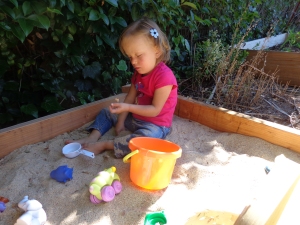 Even so, I’m super proud of how much the Bean has learned in the last year. At three-years-old, she was just beginning toddler-hood. Now she’s a mix between toddler and pre-schooler, and she learns and grows more every day. Her vocabulary is increasing, she is able to do more things on her own, she’s starting to play independently, and she’s got this great attitude about life in general.
Even so, I’m super proud of how much the Bean has learned in the last year. At three-years-old, she was just beginning toddler-hood. Now she’s a mix between toddler and pre-schooler, and she learns and grows more every day. Her vocabulary is increasing, she is able to do more things on her own, she’s starting to play independently, and she’s got this great attitude about life in general.
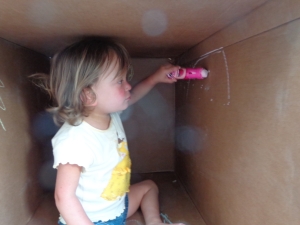 I’m pretty sure that one day she won’t be beating me up on a regular basis. Not all special needs parents can say that. I’m also pretty sure that her vocabulary and speaking skills will improve, and one day I’ll be able to understand her a lot more clearly. I have confidence that eventually she will be potty trained and I won’t be racing to get her diaper changed before she manages to get the poop into her mouth.
I’m pretty sure that one day she won’t be beating me up on a regular basis. Not all special needs parents can say that. I’m also pretty sure that her vocabulary and speaking skills will improve, and one day I’ll be able to understand her a lot more clearly. I have confidence that eventually she will be potty trained and I won’t be racing to get her diaper changed before she manages to get the poop into her mouth.
So while I don’t think I’m going to be able to “enjoy EVERY moment” of these early years, as encouraged to by parents whose kids grew up too fast, I certainly have a lot to be grateful for now, and a lot to look forward to in the future.
Health Update after ER Visit
Well, the Bean seems totally back to normal today. I kept her home just to be on the safe side, but she’s her usual talkative, active, hungry self. After our follow-up visit with her pediatrician yesterday we went for another round of blood tests, which really knocked her out for the rest of the afternoon.
Her tests all came back normal this time. No more high white blood cell count; no more low platelet count; hydration is fine. We’re still waiting for the blood and urine cultures to come back, to see if there is a deeper reason why she would have passed out the way she did. We also have a brain scan scheduled for July 9 to make sure she didn’t have an unusual type of seizure.
However, her doctor theorizes that what happened was pretty common among young children: she tried to throw up but the vomit hit her vocal chords and shut them tight, causing her to stop breathing. Apparently vocal cords are wired to do that, but it doesn’t last long enough to cause damage – hence the recovery after about 20 seconds. It doesn’t really explain why she passed out at the same time, though. He was surprised that there was no gasping for breath – just gagging and then passed out and no breathing.
Since that happened, every time I go into our bathroom, my mind goes back to the Bean lying limp in my arms, and then me leaning over her on the floor trying to bring her back. In the moment, I was all calm business, but thinking back on it makes me want to sob. I’m so grateful that we didn’t lose our little girl. She is so precious to us, and this experience has really put into perspective all the times when I get frustrated or overwhelmed by her Bean-ness. She is such a happy, friendly, spirited, smart kid, and I can’t imagine life without her.
While it’s possible that we were never actually in danger of losing our Bean on Monday night, the effects of that trauma and the gratitude I have over a happy ending will be with me for a very long time. Today I am making sure to enjoy all the kisses, cuteness, songs, snuggles, humourous moments, and even the challenges.
Long night in the ER with the Bean
The Bean was restless last night, waking up several times in a row. Sometime around 1:30am, she coughed and cried out, and wouldn’t settle back down. I picked her up to bring her to our bed thinking she just needed to be snuggled, and she was struggling with me a little. Suddenly, she started to throw up, but then just gagged. I sat down with her on the toilet seat to give her space to throw up if she needed to, and she just gagged again and then passed out. She was totally limp and it seemed like she wasn’t breathing. So scary!
I put her on the bathmat to give her a breath and check for stuff in her throat while my Sweetie called 911. By the time he was giving them our info, about 20 seconds later, she was breathing again and crying. Within 5 minutes, the house was full of rescue people (4 firemen, 2 paramedics and a sheriff). Since she was breathing again, they just asked questions while I comforted the Bean, and then to be on the safe side we went in the ambulance to the hospital. The Bean proceeded to vomit up her dinner all over me and herself (lovely), over the course of a couple of hours. They did an EKG first, which was a challenge because the machine decided to play games with us. They then had to catheterize my poor Bean to get a urine sample. That was awful. She fought tooth and nail and they had to get two nurses plus me to hold her down so the third nurse could get the catheter in.
It took a while for the lab tech to come to draw blood, and in the meantime, Bean had fallen asleep. She was woken up by a crowd of nurses hovering, ready to help hold her down, and hold her down was what they had to do. We had a break then while the lab processed the tests and she snoozed again. The nurse came back with the news that the Bean was very dehydrated and that her white blood cell count was high. They were going to have to put an IV in her arm to take more blood and give her some fluids. Poor Bean – she was already terrified every time a nurse popped in for any reason because she associates them with pain. It was quite a job getting the IV in. I didn’t watch, but there was a fair amount of blood spilled in the process, and she wailed and struggled the whole time.
An hour later, enough of the tests had come back to show that she wasn’t in any immediate danger. She doesn’t have an infection like they originally suspected. They theorized that she had eaten something that disagreed with her, choked on her vomit and passed out in the process. She did ingest some of her diaper contents earlier in the evening, but they didn’t think that had anything to do with it. We have a follow-up appointment with her pediatrician later today to go over the rest of the test results. One odd thing is that her platelets have been decreasing over the past few months, affecting her blood’s ability to clot. We don’t know why right now, but hopefully the doctor will have some info for us this afternoon.
So, we’ve collected another hospital bracelet.
One thing I have to say, though, despite my exhaustion from not having slept at all last night, is that every person we encountered last night was wonderful. The paramedic has a 4-year-old daughter, and he was so great with the Bean. He presented her with a cute stuffed bunny, and at the hospital obtained a second id bracelet and attached it around the bunny’s leg. She was so much more interested in the bunny after that.
The main nurse in charge of the Bean’s case also has a 3-year-old son who has medical special needs. He was just as wonderful, despite the many challenges in dealing with the Bean’s tests. We chatted about our kids while he filled out paperwork. All the assisting nurses were so sweet and helpful. The doctor was a gentle giant: tall, muscular and extremely kind and soft-spoken.
I certainly didn’t like having to be in the ER overnight, but we had such kindness and support surrounding us that it made the whole experience manageable. Here’s hoping we all get some sleep today.
Just TALK to me: Frustrations in Toddler Communication
As much as I love my Bean and as proud as I am of her, there are days that feel too hard. I’m sure most parents feel that way. We’ve had a few of these recently, probably in part because she’s been off from school for the holidays, and our routine is out of whack.
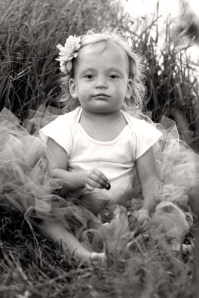
Photography by Sasha Georgeson
These days, one of my biggest challenges with the Bean (besides my lack of sleep) is communication. She’s going to be four years old in March, and while she’s come a long way (baby), figuring out what she wants is still often a guessing game. Yesterday morning, she woke up way too early and was wailing about something. Now, most kids her age can say, “Mommy, I want to get up and play”, or “I’m hungry. I want some cereal for breakfast”. But this morning, all I got was a cranky, “Naaahh”. Sometimes this means, “I’m hungry, I want a snack”; sometimes it means, “I’m uncomfortable – something’s wrong”; yesterday morning I think it meant, “if you make me go back to bed I’m going to make sure you’re as miserable as I am”.
All babies start out being unable to clearly communicate what they want. Their parents learn to interpret their cries and it starts to get easier, and at the same time, those babies learn to talk. By one year old, the average child can string together a few words and start to control their world through language. They figure out that “more milk” gets them what they want faster than just saying “more” on it’s own.
The Bean took a little longer than most to get those first words, although sign language really helped. Learning the signs for her basic needs, and being able to teach them to her, was a huge relief. “Milk”, “food”, “play”, “all done” and “more” were indispensable tools in our arsenal, and we learned a bunch of other signs that were part of her world and helped her to talk, but were not necessarily included in the “needs” category.
However, as her wants and needs get more complex, it’s getting harder and harder to interpret them with the few words she uses regularly. Her vocabulary is growing a lot more quickly these days, and when the Bean is calm, she can actually put together five-word sentences: “I want more milk please” (Sounds like “Ah wah moh mih eee”). Unfortunately, as soon as the Bean is upset, when she needs to be able to communicate most clearly, she forgets that she has any words at all.

Photography by Sasha Georgeson
According to Dr. Harvey Karp (author of the “The Happiest Baby-” and “The Happiest Toddler on the Block” books), toddlers become “cave kids” when their emotional state gets too elevated. Their brains go into a mode that doesn’t allow any sort of reason to leak through. It seems, though, that the Bean’s emotional state still gets heightened immediately, when most kids her age are getting to the point where they can control their emotions a little better. For example, the second a show she’s watching is over, she’s screaming, “Moe, moe, moe” over and over again as if it were the end of the world. As with all toddlers, we’re working on the concept of patience. In this particular situation, the context is so specific that I know exactly what she wants, and often, even if I say, “No, we’re all done watching TV” , she repeats “Ah duh” and is happy to be led to another activity. But all too often, I have no context to her crying and it takes a while to figure it out.
I think this time in the Bean’s life is particularly difficult for communication because she has many of the needs and wants of kids her age. She also gets frustrated very quickly, which is totally normal and appropriate for her developmental age, if not her chronological age. But her disadvantage is that she doesn’t have the vocabulary to go with those more complex needs and her heightened emotional state. Her frustration gets exacerbated because it takes me longer to understand her, and then we cycle into a downward spiral of louder crying from the Bean and increased anxiety on my part, and nothing getting accomplished until I finally stumble on the thing she wants. AHHHHH!
I need to keep reminding myself that all my friends with preschoolers went through this with their kids when they were still toddlers, it’s just that we’re doing it later and it will last longer. Even though the Bean is a preschooler, she’s also still a toddler, and that’s just the way it is for us. It is sometimes comforting to tell myself that God gave the Bean to us because we are the best parents for her needs. I believe that I am becoming a stronger person and a better mother as I learn from each situation we come across. I’m realizing more and more that I also can’t do this without God and my husband. If I were a single mother, I think I might go over the edge. And I can’t even imagine what adding another baby to the situation would do to us, when the Bean still needs so much help, so that’s definitely off the table.
Thankfully, there are plenty of days when things go very well and the Bean is a happy-go-lucky kid with a positive attitude. Even the difficult days aren’t all bad – we always figure things out eventually and move on. Some days include tears in my eyes or frustrated pillow-punching, but most don’t. Some days I feel supported and encouraged by friends and family, and some days I feel like I’m the only one in the world dealing with these things, even though I know I’m not. It helps to write about it; it helps to read about it; it helps to discuss particular issues with her teachers and therapists; and it definitely helps to get together with other moms and discuss everything from how long it’s been since we’ve had a bubble bath to discipline strategies for our toddlers.
I am supremely grateful for all the support and encouragement I receive from my friends, family, and acquaintances. And to tell the truth, the Bean herself is the best reward and encouragement for all my hard work. She is usually a happy, cuddly, funny little girl who makes me feel like I’m the most important person in the world.
Leaps and Bounds
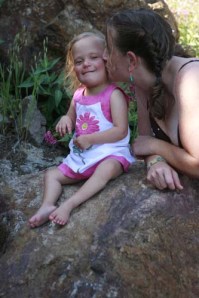 My Bean is growing in every way all of a sudden. She has moved up a size in clothes, which is super exciting for me because I was getting tired of dressing her in her 12 month stuff. For those not familiar with the Bean, she’s tiny – 3 3/4 years old and now wearing 18 – 24 month clothes. What mom doesn’t love new clothes, even if they’re for her child and not for herself?
My Bean is growing in every way all of a sudden. She has moved up a size in clothes, which is super exciting for me because I was getting tired of dressing her in her 12 month stuff. For those not familiar with the Bean, she’s tiny – 3 3/4 years old and now wearing 18 – 24 month clothes. What mom doesn’t love new clothes, even if they’re for her child and not for herself?
Walking is the Bean’s favourite hobby. She toddles around everywhere, dancing if there is music and running (sort of) if she’s super excited. She sure keeps me hopping when we’re in public – her curiosity knows no bounds, so she’s off the second I put her down. A whole new world has opened up to her and it is so much fun to help her explore and discover new things.
She keeps herself busy while I’m working in the kitchen by removing plastic containers from the cupboard and distributing them around the house. She loves to “help” me wash dishes, standing on a chair at the second sink with her own bowl of sudsy water. While it makes a huge puddle on the floor, and she keeps stealing the clean dishes from the rack and putting them back in my dishwater, it can be tremendous fun. I still eventually get the dishes done.
Laundry is a similarly fascinating chore. Bean likes to push the buttons on the washer and dryer, so after we load them, she closes the door and gets them started. She recently started taking clean clothes out of the laundry basket and putting them away in her drawer. As long as I’m one step ahead of her, she manages to put the right things away in the right places and I don’t have to reorganize when she’s done.
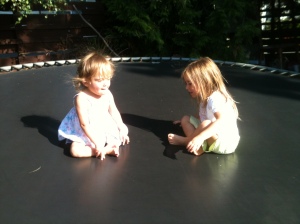 The challenge of communicating with the Bean is starting to get a little easier. She attempts to copy everything we say, and it’s been a blast finally being able to teach her new words and have her respond. With Christmas coming up in a few days, we were thrilled that she has learned to recognize and sort of say “Santa”. We’re still working on “Baby Jesus”. She had a Santa cupcake at her Christmas party, and since she associates cupcakes with birthdays, she wanted to blow out a candle. I used that opportunity to remind her that it is Baby Jesus’ birthday, and we sang and pretended to blow out a birthday candle. So cute. However, the fact is that Santa is a much more compelling symbol for a toddler – bright colours, concrete concepts, and presents…the importance of the birth of Jesus is a little too abstract for her yet.
The challenge of communicating with the Bean is starting to get a little easier. She attempts to copy everything we say, and it’s been a blast finally being able to teach her new words and have her respond. With Christmas coming up in a few days, we were thrilled that she has learned to recognize and sort of say “Santa”. We’re still working on “Baby Jesus”. She had a Santa cupcake at her Christmas party, and since she associates cupcakes with birthdays, she wanted to blow out a candle. I used that opportunity to remind her that it is Baby Jesus’ birthday, and we sang and pretended to blow out a birthday candle. So cute. However, the fact is that Santa is a much more compelling symbol for a toddler – bright colours, concrete concepts, and presents…the importance of the birth of Jesus is a little too abstract for her yet.
My favourite part of parenthood these days is playing with the Bean. She has a great imagination and loves to make jokes and laugh. Her jokes usually involve some sort of slap-stick comedy, and she giggles uncontrollably at her own antics. She loves to be tickled and startled, asking for “moh” (more) over and over again. At the playground, she enjoys climbing the structure and sliding with me down the big-kid slide. When we get to the bottom, she pretends to be a chicken as she waddles back to the stairs again, flapping her wings and clucking, “buh, buh, buh”.
 Preschool continues to be an awesome experience for the Bean. Her teacher is on maternity leave, but they’ve had a string of wonderful substitutes in the meantime, and the teacher’s assistants are a stable presence for the kids in their teacher’s absence. Bean is apparently the “angel” of the class – the sweetest and least disruptive. Of course she is – she’s her mother’s daughter! But seriously, I feel very fortunate that her diagnosis doesn’t come with an expectation of major behavioral challenges. She certainly gets frustrated and can be persistent about having things her way, but unlike some of the other kids in her class, she doesn’t tend to lash out physically or flop down on the ground in protest. At her most aggressive, she’s just really loud and squirmy. I get more resistance from her at home than they do at school, I think, but that’s pretty normal for most kids.
Preschool continues to be an awesome experience for the Bean. Her teacher is on maternity leave, but they’ve had a string of wonderful substitutes in the meantime, and the teacher’s assistants are a stable presence for the kids in their teacher’s absence. Bean is apparently the “angel” of the class – the sweetest and least disruptive. Of course she is – she’s her mother’s daughter! But seriously, I feel very fortunate that her diagnosis doesn’t come with an expectation of major behavioral challenges. She certainly gets frustrated and can be persistent about having things her way, but unlike some of the other kids in her class, she doesn’t tend to lash out physically or flop down on the ground in protest. At her most aggressive, she’s just really loud and squirmy. I get more resistance from her at home than they do at school, I think, but that’s pretty normal for most kids.
 Mostly, these days, she feels like a delightful 2-year-old. It seems appropriate to me that her mental age seems to fit her physical age, even if they don’t correspond with her chronological age exactly. She’s starting to get interested in dolls and playing dress-up. If they didn’t make her also do other activities, she would be a permanent fixture in the play kitchen at school. At home she loves to build with and knock down blocks, pull stickers off their sheets and stick them everywhere, have tea parties with Elmo, and get dirty in her sandbox. When I’m digging around in the garden, she joins me, although a lot of soil still goes in her mouth.
Mostly, these days, she feels like a delightful 2-year-old. It seems appropriate to me that her mental age seems to fit her physical age, even if they don’t correspond with her chronological age exactly. She’s starting to get interested in dolls and playing dress-up. If they didn’t make her also do other activities, she would be a permanent fixture in the play kitchen at school. At home she loves to build with and knock down blocks, pull stickers off their sheets and stick them everywhere, have tea parties with Elmo, and get dirty in her sandbox. When I’m digging around in the garden, she joins me, although a lot of soil still goes in her mouth.
Our biggest challenge with the Bean continues to be her sleep habits. Currently, she mostly sleeps with us in our bed. She won’t settle and fall asleep at night time without one of us lying beside her. If we do put her in her own bed, she wakes up an hour later and we have to do it again. She still takes naps but if she sleeps for more than an hour in the afternoon, she’s up until 9 or 10 pm, which means that my Sweetie and I don’t get much of an evening together. We’re working on some strategies to get her sleeping consistently in her own bed. She is too persistent at this point for the Cry-It-Out method, and frankly, I’m too soft-hearted to be able to stand it. I think part of it is that she’s just a very physically affectionate child. She needs the reassurance and comfort of a snuggle – I say there are worse things in this world than that, for sure.
Potty training is in the concept stage right now. She’s starting to make it known when she needs a diaper change. We’re working on recognizing when she’s actually going so we can start to preempt it and get her to the toilet. But she doesn’t like sitting on the potty or on her little toilet seat, so we’re trying to get her used to that first. As with most things in the Bean’s life, it will take a lot more time than it does for most other kids. That’s just the way it is for us. And in the meantime we’re helping to keep Pampers and Tide in business.

I predict that the coming year will be one of even bigger leaps and more impressive bounds. Our Bean will be turning 4 in March – it’s surreal to think about. I feel like I’m finally coming into my own as a mother. The extended infant stage was not my ideal situation…as much as I love babies, having one for 3 years while all the other kids are changing rapidly was a little disheartening and quite difficult for me. As always, though, when I look for the silver lining it’s there. Most mothers mourn the speedy passing of the infant stage. I got to coddle and snuggle and baby my little one a whole lot longer than most moms before she became a wriggly wild thing. Every milestone reached tastes that much sweeter because of the struggle it took to get there. I don’t take anything about the Bean for granted. I marvel at how far she’s come in the last year and I feel grateful for all the help we have along the way.
What a blessed life we live!
Maybe Not My Proudest Parenting Moment
Today I stumbled across a section of the Family Matters blog site that focuses Raising a Child with Special Needs. I read the most recent post and found myself in tears. After a break to collect myself, I went back to the blog to explore further, and found myself in tears again and hugging the Bean close. Okay, something is going on with me today. Obviously I have some unresolved pain around the Bean’s Journey so I decided to explore it…in public on the blog of course.
In general, I’ve tried to remain positive on this blog: I acknowledge challenges but try to put a positive spin on them. And I don’t think there is anything wrong with that; there is something to be said for maintaining a positive attitude. But it would be dishonest to pretend that I always deal with those challenges in a constructive way.
One of the Bean’s persistent “bad” habits is pinching. She finds the most sensitive bits of skin on my body, such as the tender skin at the back of my upper arm, on my throat, or on my breasts, and squeezes them hard in her considerable pincer grasp. She’s not doing it to be mean or spiteful. It’s something she does to comfort herself when she’s upset, or to show her affection, or to get my attention when I’m focused elsewhere. It almost seems totally unconscious.
I hear that this type of pinching is not the exclusive domain of Special Needs kids – my friend’s 3-year-old once pinched her regularly, and her 1-year-old currently tortures her with pinches. But with the Bean, the habit is not going away as she gets older. I tell her that Mommy doesn’t like her pinching and ask her to stop, but that doesn’t work at all. Sometimes I make a joke about it and tickle her to distract her, but that only works temporarily. I pull myself away, or tap her hand to remind her that pinching is not okay, but she only goes back to it.

These emotions portrayed by Jane Lynch show exactly how I feel when the Bean overwhelms me. (photo by Howard Schatz)
Yesterday, I was trying to make dinner and the Bean was being needy and clingy. I had been trying to keep her entertained while doing dinner prep and nothing was keeping her attention for more than a couple of minutes, not even the all-engrossing television. I got frustrated and snapped at her for the constant whining, feeling totally overwhelmed. My Sweetie came home and took her off my hands for a few minutes (thank goodness!) but then left to dress down and get ready for dinner.
The Bean continued to complain, and I finally gave in and carried her on my hip while I stirred the food on the stove. As usual, she started to pinch and I used my well-worn ineffective tactics to no avail (definition of insanity: doing the same thing and expecting different results?). Annoyed, but not yet angry, I very calmly decided to teach her a lesson. She obviously did not understand what I was telling her about the pinches hurting Mommy. So I evenly said to her, “This is what your pinches feel like”, and I pinched a small portion of her tender skin between my thumb and forefinger.
She looked at me in shock for a second before her lower lip puckered out and she started to cry – a good honest cry – no whining anymore. My Sweetie came into the kitchen to see what else needed to be brought out to the table and I gave him the Bean, explaining what I had done. I felt a little bad for making her cry, but only a little. This girl pinches me A LOT! He comforted her, we had dinner, and then I put a very tired Bean to bed.
Looking back, I’m not sure how I feel about that moment. Was it wrong of me to pinch my little girl? I didn’t do it out of anger, but as a genuine attempt to help her understand what she was doing to me. Still, was there a less violent way for me to teach that lesson?
I’d love any suggestions from my wonderful readers!


